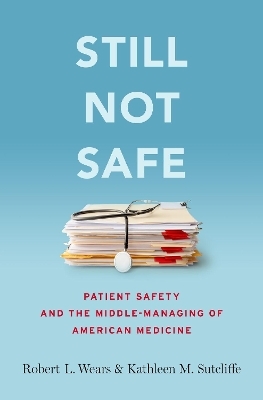
Still Not Safe
Oxford University Press Inc (Verlag)
978-0-19-027126-8 (ISBN)
Still Not Safe is the story of the rise of the patient-safety movement -- and how an "epidemic" of medical errors was derived from a reality that didn't support such a characterization. Physician Robert Wears and organizational theorist Kathleen Sutcliffe trace the origins of patient safety to the emergence of market trends that challenged the place of doctors in the larger medical ecosystem: the rise in medical litigation and physicians' aversion to risk; institutional changes in the organization and control of healthcare; and a bureaucratic movement to "rationalize" medical practice -- to make a hospital run like a factory.
If these social factors challenged the place of practitioners, then the patient-safety movement provided a means for readjustment. In spite of relatively constant rates of medical errors in the preceding decades, the "epidemic" was announced in 1999 with the publication of the Institute of Medicine report To Err Is Human; the reforms that followed came to be dominated by the very professions it set out to reform.
Weaving together narratives from medicine, psychology, philosophy, and human performance, Still Not Safe offers a counterpoint to the presiding, doctor-centric narrative of contemporary American medicine. It is certain to raise difficult, important questions around the state of our healthcare system -- and provide an opening note for other challenging conversations.
ROBERT L. WEARS, MD, (1947-2017) was Professor in the Department of Emergency Medicine at the University of Florida and Visiting Professor in the Clinical Safety Research Unit at Imperial College London. His research focused on technical work studies, joint cognitive systems, and understanding the nature of safety and resilience in complex socio-technical systems, including medicine and healthcare. KATHLEEN M. SUTCLIFFE, PhD, is Bloomberg Distinguished Professor at Johns Hopkins University with appointments in the Carey Business School, School of Medicine, and the Armstrong Institute for Patient Safety and Quality. Her interests lie in understanding how high-hazard organizations and systems manage for the unexpected and how they can be designed to be more reliable and resilient.
Preface
Acknowledgements
Part I: The Rise of Patient Safety
1. Setting the Stage
2. Beginnings
3. Rationalizing Health Care: Scientific-Bureaucratic Medicine
4. The Special Case of Anesthesia
5. Three Views of 'Human Error'
6. Halting Steps: Early Work on Patient Safety
7. Pressure Builds for Reform
Part II: The Reign of Patient Safety
8. Irruption
9. Institutionalization
10. Consolidation and Stagnation
Part III: The Waning of Patient Safety
11. Reflections
12. The Future of Patient Safety
Afterword
Glossary
Bibliography
| Erscheinungsdatum | 04.12.2019 |
|---|---|
| Verlagsort | New York |
| Sprache | englisch |
| Maße | 163 x 236 mm |
| Gewicht | 544 g |
| Themenwelt | Studium ► Querschnittsbereiche ► Geschichte / Ethik der Medizin |
| ISBN-10 | 0-19-027126-4 / 0190271264 |
| ISBN-13 | 978-0-19-027126-8 / 9780190271268 |
| Zustand | Neuware |
| Haben Sie eine Frage zum Produkt? |
aus dem Bereich


